This Grilled Salmon in Foil is sponsored by Danish Creamery Butter. All opinions are my own.
Grilled Salmon in foil is foolproof! It creates, tender, juicy salmon dripping with buttery flavor with only minutes of prep and almost zero cleanup!
Grilled Salmon in Foil couldn’t be any easier or more delicious, making it a perfect weeknight meal or impressive enough to serve guests. This easy tutorial on How to Grill Salmon in Foil eliminates all of the guesswork and delivers gloriously juicy salmon every time. First, the salmon is marinated in a tangy, sweet and spicy Cajun honey mustard marinade, then topped with cubed Danish Creamery Butter, sealed in foil, then grilled (or baked) until flaky tender in about 15 minutes. As the salmon cooks, the foil seals in extra flavor and moisture and the butter melts, creating a self basting buttery bath, guaranteeing boldly flavored, beautifully moist and tender salmon with slightly smoky undertones; no flipping the salmon and no worrying about it sticking! I’ve included all the best tips for how to know when salmon is finished cooking, what temperature to cook salmon to, what to serve with salmon, and more! Finish off this effortless grilled salmon dinner with a side of watermelon feta salad and loaded potato salad for the perfect summer meal.
Buttery tender salmon is always a quick and easy winning dinner – head here to see all my salmon recipes! If you’re looking for more salmon recipes, be sure to check out: honey garlic salmon, Tuscan salmon, sheet pan garlic butter salmon, salmon pasta, teriyaki salmon, blackened salmon in creamy Cajun sauce, baked Greek salmon with dill sauce, Asian BBQ salmon and sheet pan fajita salmon.
PIN THIS RECIPE TO SAVE FOR LATER
how to make Grilled salmoN in foil video
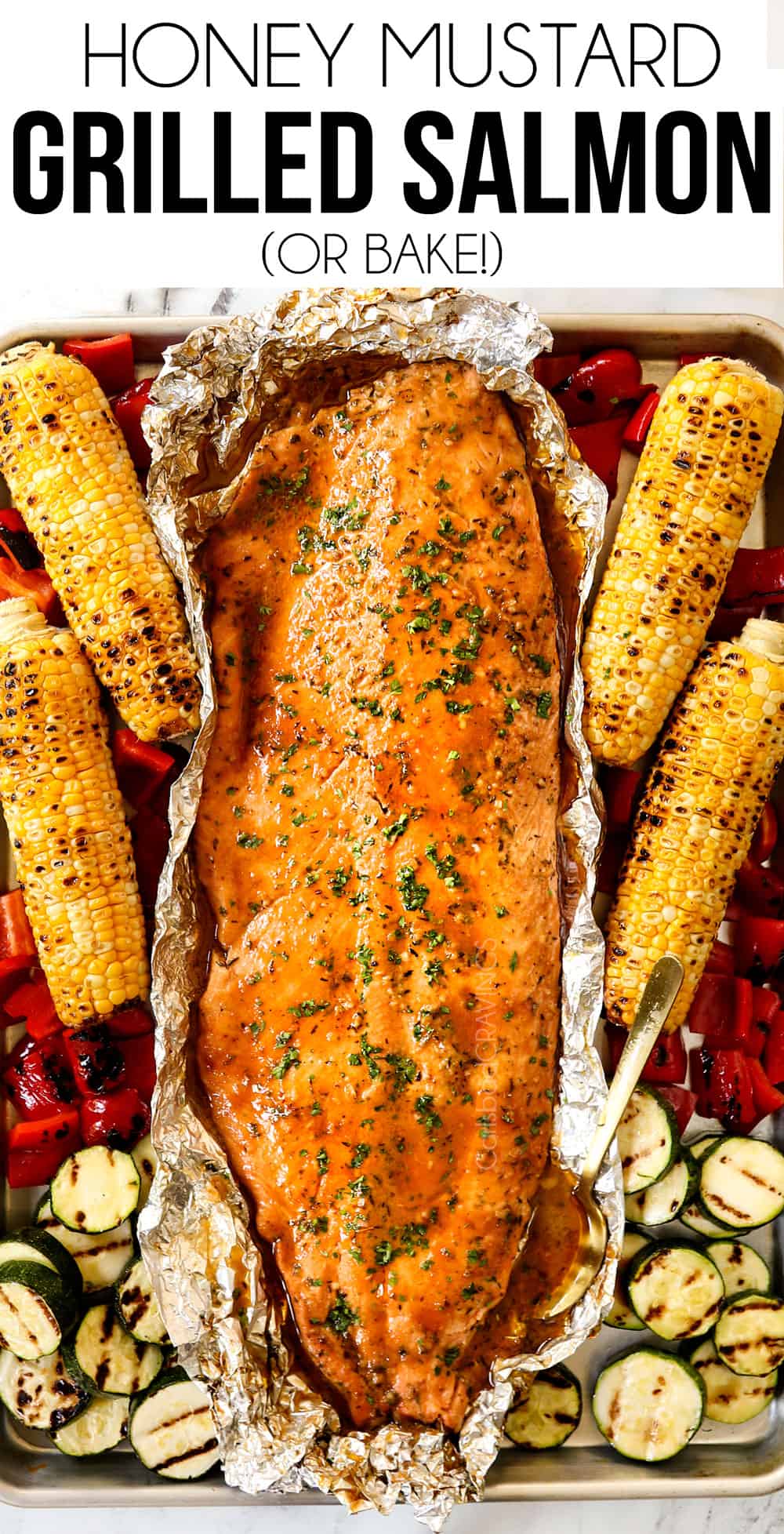
What Is Salmon in Foil?
Salmon in foil is essentially a large-scale version of salmon en papillote, or salmon steamed in a parchment paper packet – but in foil! This classically French method of cooking salmon in a packet boasts many benefits which make for an easy summer meal: the fish is super easy to grill, cooks evenly, and cleanup is a breeze, just to name a few. Here are more reasons to love salmon in foil:
Why grill salmon in foil?
If you are intimidated to cook fish or grill fish, this Grilled Salmon in Foil recipe is for you! Plus, it boasts so many additional benefits:
- Super-moist salmon. This is probably the number one reason to grill salmon in foil. The steam-cooking that occurs on the grill traps the juices released by the salmon and marinade in the foil, causing the fish to steam instead of sear, imbuing the salmon with extra moisture while it cooks.
- Super flavorful salmon. The juices released by the fish, plus the marinade and the crowing butter are tightly sealed in the foil as it bakes and reabsorbed back into the fish. This means none of the flavors are lost, but instead, penetrate deeply into the salmon.
- Foolproof easy, even cooking. Just add the salmon in foil to the grill and walk away and the fish will cook evenly every time! No need to flip the packets or move them around or worry about the salmon falling apart, sticking to the grill or causing flareups.
- Easiest way to serve salmon to a crowd. Because of all of the aforementioned reasons, grilled salmon in foil is by far the easiest way to serve salmon to a crowd. Set the timer, socialize, then come back to succulent, tender, flaky salmon. Plus, it’s exactly what you need to break up the tired monotony of hot dogs, burgers and chicken.
- Easy clean up. The only dish you’ll have to wash is the bowl you whisked the marinade in! The marinade is poured directly over the salmon in the foil, so once the fish is served, throw the foil away and that’s it!
- Adaptable. You can use this grilled salmon in foil method for almost ANY salmon recipe! Just add the salmon to the foil and cover in the marinade. Try it on teriyaki salmon, Asian BBQ salmon or chipotle lime salmon.

About this GRILLED SALMON RECIPE
This Grilled Salmon in Foil is a happy accident. I was going to make grilled salmon directly on the grill, but my husband accidently purchased skinless salmon, so I quickly came up with this recipe. And honestly, I have never sunk my teeth into more tender, moist salmon in my life. Part of that is the butter bath that drenches the salmon as it cooks, and part of it is the trapped moisture in the foil that makes for the juiciest salmon of your life.
As far as the flavor profile, I was inspired by my Cajun Honey Mustard Chicken with only rave reviews. There are tons of garlic butter salmon recipes out there, and you certainly make this recipe with my version (omit the panko because it won’t get crispy), but the Cajun Honey Mustard is intoxicating. It’s a marriage of paprika, garlic, cayenne forward Cajun seasonings with honey mustard sauce spiked with orange juice and soy sauce. It’s sweet, tangy, full of flavor and one of the most rewarding recipes of the season.
Lastly, what truly elevates this recipe is that it’s dotted with cubes of Danish Creamery butter before being sealed and grilled. The butter melts as the salmon cooks, mingling with marinade and creating a drool worthy decadent, buttery sauce you’ll want to drink. Spoon this self-made butter sauce over the grilled salmon and drool.
WHY USE DANISH CREAMERY BUTTER?
My husband and I both LOVE Danish Creamery Butter! Butter is all about flavor and luxurious creaminess and no one does that better than Danish Creamery – you can literally taste the velvety, rich difference!
Danish Creamery butter is made with high quality cream from pasture-raised cows since 1895. Their European Style Butter boasts an 85% butterfat (much higher than most other European Style butters which come in at 82-83%) making it a dream in sauces, baking, or even just to spread on toast.
Add Danish Creamery Butter to this grilled salmon in foil recipe (and all your other recipes) and instantly elevate your cooking!
GRILLED SALMON INGREDiENTS
All of the flavor comes from the butter and the marinade. Here’s what you’ll need:
- Olive oil: use extra virgin olive oil for the best flavor.
- Honey: sweetens the marinade and adds a lightly floral flavor.
- Brown sugar: further sweetens the marinade with the depth of molasses.
- Orange juice: adds fruity tanginess to complement the mustard. Use freshly squeezed or 100% bottled orange juice not from concentrate.
- Dijon Mustard: made from ground hotter brown or black mustard seeds and white wine which give it a sharp, pungent flavor with a little heat.
- Yellow Mustard: a mild, smooth mustard made from fine ground yellow mustard seeds and turmeric for a clean mustard taste. I like using a mix of both Dijon and yellow mustard for a balanced, complex mustard tang.
- Soy sauce: grounds the sauce. Use reduced sodium so it’s not too salty, or reduce the salt in the recipe.
- Garlic: add garlicky goodness! Use more or less to taste. You may also substitute wit 1 teaspoon garlic powder.
- Homemade Cajun seasoning: smoked paprika, garlic powder, onion powder, dried parsley, dried oregano, dried thyme, pepper, salt and cayenne pepper round out the flavor profile.
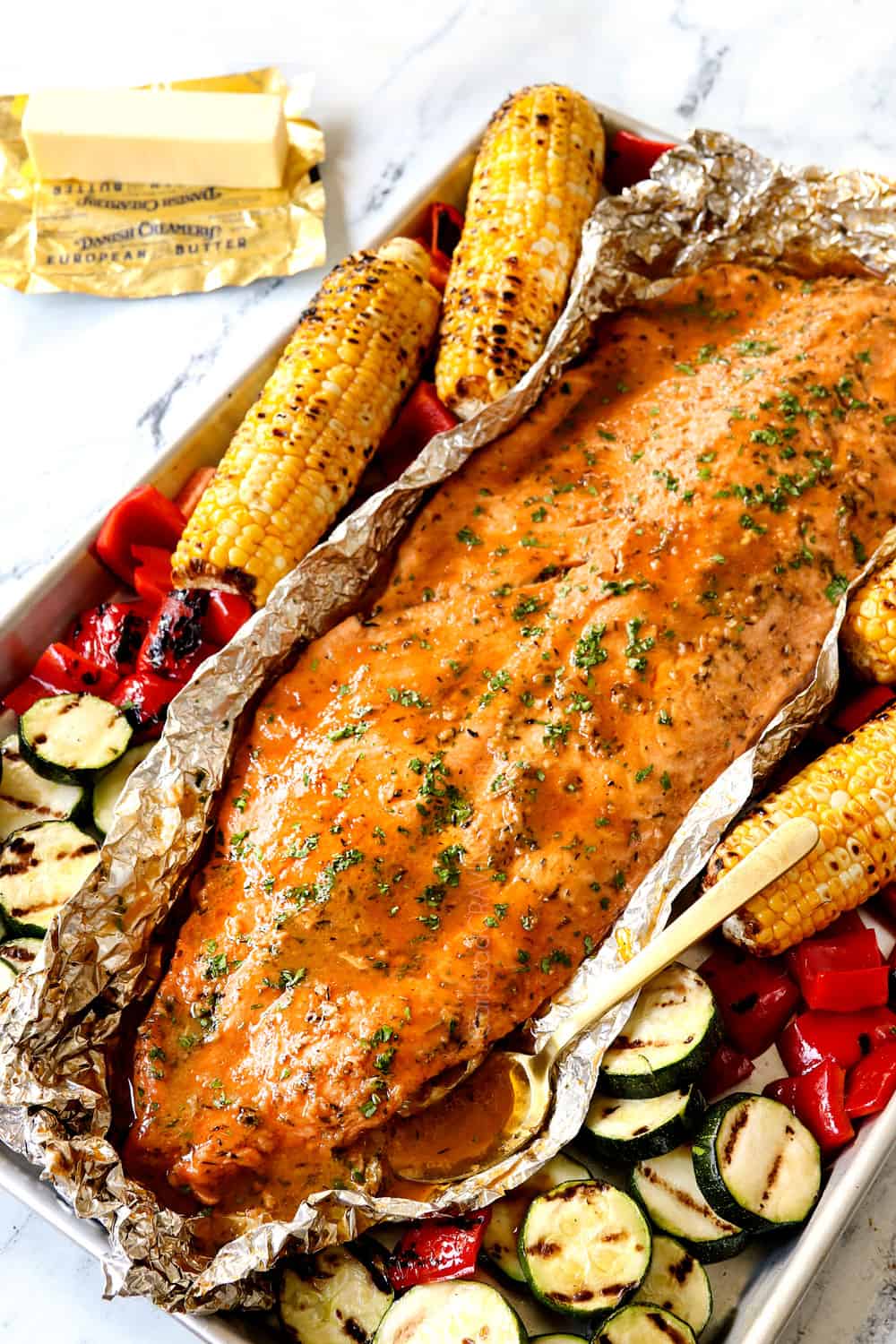
RECIPE VARIATIONS
- Too cold or rainy to grill? Bake the salmon! Make “grilled” salmon in foil right in your oven. Add the salmon to the foil and marinate per recipe instructions. Bake in foil on top of a baking sheet in the oven at 400°F for 12-15 minutes, or until flaky tender.
- Make it spicy. Sprinkle the Grilled Salmon with cayenne pepper just before serving or add additional cayenne pepper to the marinade.
- Swap the mustard. Use all Dijon or all yellow, depending on what you have in the fridge. But I have to say, the flavor won’t be quite as good.
- Make it sweeter. Add additional honey or brown sugar to the marinade.
- Add fresh herbs. Add 3X fresh herbs to dried herbs in the case of parsley, oregano and thyme. You can also add cilantro, chives or other favorite herbs.
- Mix up the seasonings. This salmon recipe can be seasoned however you like. You can select any of my marinades or spice rubs used on other proteins from fish to chicken to steak. Just don’t skip the butter 😊. Keep reading for more ideas for salmon.
How to make grilled salmon in foil
This grilled salmon in foil is quick, easy and delicious. Here’s how to make it with helpful tips (see recipe card at the bottom of the post for the full recipe with measurements):
Step 1: To Make the Best Grilled Salmon in Foil, Start by Selecting the Best Fish
- Use a fresh salmon fillet, about 3 pounds. Look for salmon that is bright pink in color, smells fresh but not fishy, and, if possible, is wild caught. I prefer wild caught salmon (king, coho and sockeye) because it has richer flavor, but if you want milder flavor, than farm-raised Atlantic salmon might be the way to go. Atlantic salmon can cook up watery or mushy due to the artificial diet but I have had success with farm raised salmon from Costco, they seem to have higher quality suppliers.
- Do I grill salmon in foil with the skin on or off? For Grilled Salmon in Foil, you can grill the salmon with the skin on or off. The skin doesn’t really serve a purpose because it won’t get crispy because the fish is being steamed on the grill and we don’t need the skin to hold the fish together because the foil does that for us. That being said, sometimes, it’s just easier to remove the skin after it’s cooked!
Step 2: Lay out Foil on a Baking Sheet
- You will need two large pieces of foil to securely wrap the fish in. Two pieces of foil also makes the foil packet sturdier.
- I also recommend using a heavy-duty foil because it’s less likely to tear when transferring the fish to the grill. If you don’t have heavy duty foil, then you’ll want to double up the foil.
- To prep the foil, line a large baking sheet (large enough to hold your salmon) with heavy duty foil that is 6-inches longer than your salmon (so you can fold the sides up). Lightly spray the foil with cooking spray. Place the salmon in the center and fold the foil up snuggly around the salmon to create a boat to hold in the marinade.
- If you do not want your salmon to touch the foil directly, you can lay a sheet of parchment paper on top of the foil. Cooking food directly in foil is a health concern to some, but the aluminum it may add to your diet is negligible (I’ve detailed that below). Still, so do whatever makes you the most comfortable.
- Adding the salmon to the baking sheet makes for easy transportation of the salmon to and from the grill – slide it on and slide it off! It’s easier to line the foil on top of the baking sheet instead of transferring the salmon to the baking sheet after it’s wrapped in foil. The less you have to handle the foil salmon packet, the better, because there will be less chances of it tearing. I recommend a flat baking sheet if you have one for easiest sliding ability.
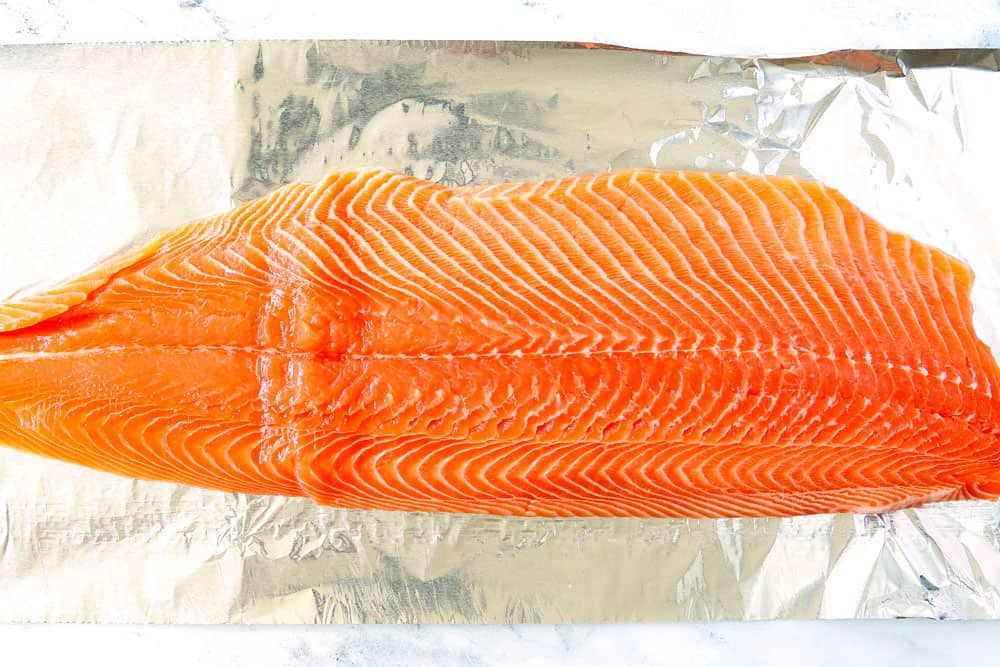
Step 3: Marinate the salmon in the foil
- The marinade is crucial to create grilled salmon EXPLODING with flavor. First, whisk together the marinade ingredients in a bowl: olive oil, orange juice, soy sauce, honey, brown sugar, mustards and seasonings, then pour it all over the salmon.
- Let the salmon marinate at room temperature for 20-40 minutes. Prep the grill the last 15 minutes of marinating.
- Marinating the salmon also brings it to room temperature. You should never grill salmon straight from the refrigerator. It needs to rest at room temperature before cooking in order for it to cook evenly otherwise you are left with an overcooked exterior and cold interior. Bringing the salmon to room temperature also relaxes the cold muscle fibers so they release natural moisture which is then reabsorbed into the muscle for juicier results (otherwise the moisture stays trapped in the fibers).
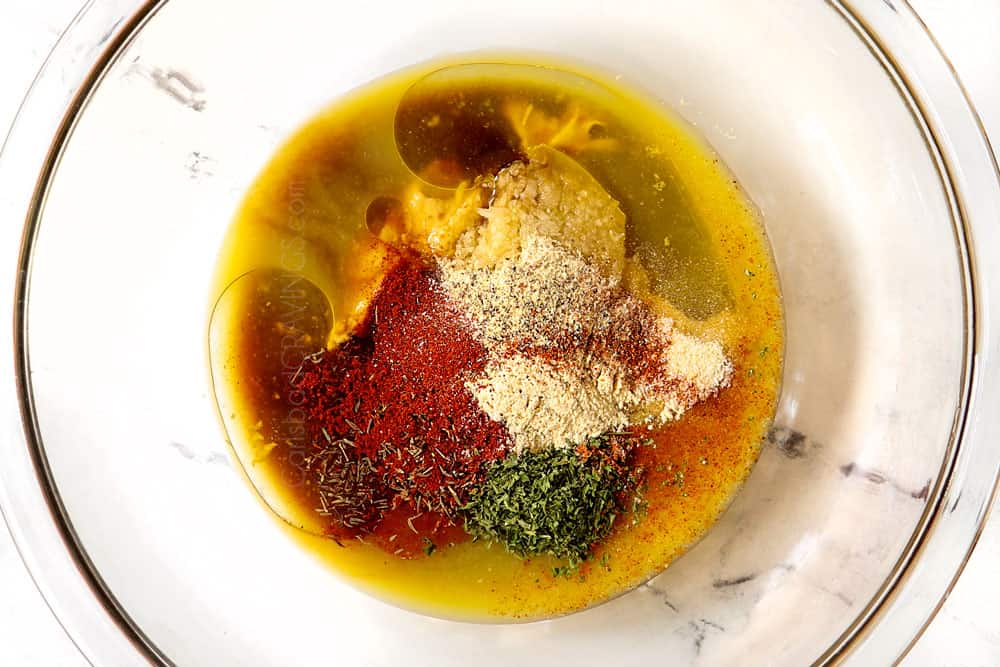
Step 4: Add Butter
- Grilled salmon in foil is ideal for topping with butter because the foil holds in all the melted buttery goodness created a self-basting sauce.
- You will need 3 tablespoons cubed Danish Creamery Butter. Evenly distribute the butter all over the top of the salmon.

Step 5: Seal the salmon in the foil
- To seal the salmon in foil, bring up the long ends and top with a second piece of foil on top. Fold the edges under to form a sealed packet.
- You want to leave little room over the salmon when folding for tented for air circulation, but the foil ends should still be overlapping so nothing can escape.
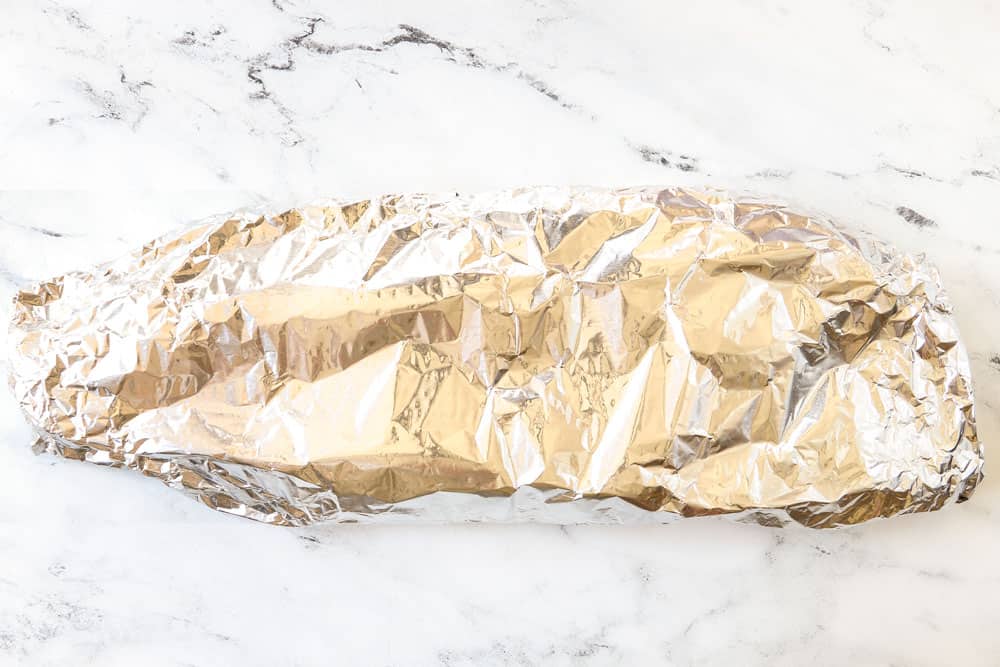
Step 6: Heat, Clean and Grease the Grill
- Heat the grill to 375 degrees F with the lid closed.
- Once the grill is fully heated, clean it thoroughly with a wire grill brush. It’s easiest to remove old food after the grill is super-hot and the old bits of food start to char and crumble. A clean grill ensures direct contact with the foil which prevents sticking.
Step 7: Grill salmon
- Salmon should be grilled over medium heat, about 375 to 400 degrees F when the lid is closed. Make sure to only add the salmon to the grill once it is hot. Slide it off of the baking sheet in the middle of your grill so it cooks evenly.
- Once you add the salmon, close the lid and grill for 10-20 minutes. The cooking time will vary based on the thickness of your salmon, so I always recommend an instant read thermometer (tips on cooking times below).
- This grilled salmon in foil recipe has been tested on a gas grill but will also work for a charcoal grill or Traeger grill, or in the oven. The cooking time will be the same as long as you maintain the same temperature

Step 8: LET THE SALMON REST
- After your grilled salmon is finished cooking, carefully slide it back onto the baking sheet with tongs or a spatula because the foil will be very hot.
- Transfer the salmon to a heat-proof flat surface and carefully remove the top piece of foil. It will release a lot of steam, so take care to remove the foil away from you.
- Spoon the buttery sauce accumulated at the bottom of the foil all over the top of the salmon.
- Let the grilled salmon rest for 5 minutes before serving. While the salmon cooks, the juices are forced away from the heat to the middle of the fish. The resting time allows for the redistribution and reabsorption of the juices throughout the whole fillet for optimal flavor and juiciness.
- After the resting time, slice the salmon into individual fillets and serve with your choice of sides (lots of ideas to follow).
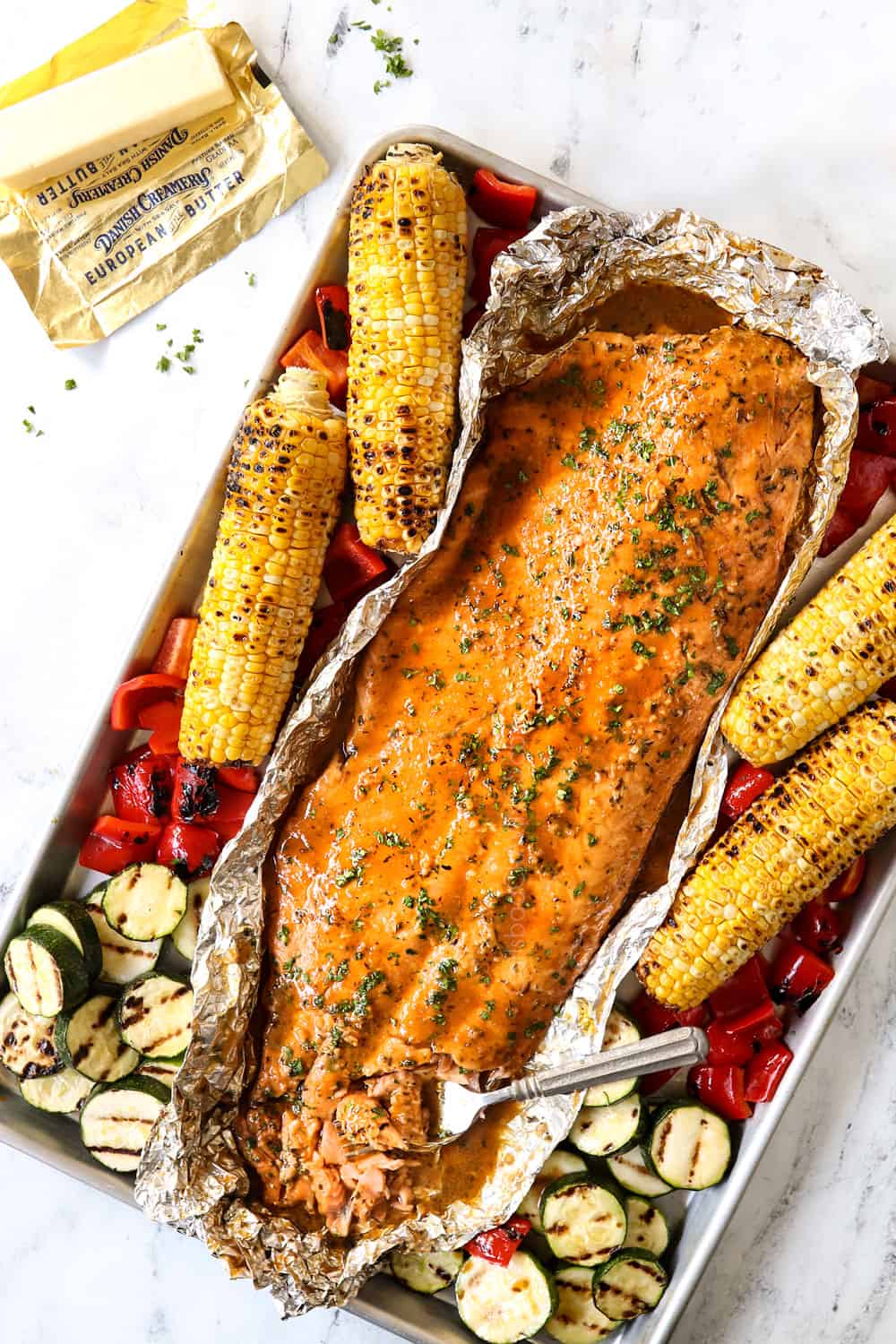
HOW LONG DO YOU COOK SALMON ON THE GRILL?
The salmon cooking time will depend on its thickness. A large, thick piece of salmon, closer to 1 ½ inches thick (pictured) will take around 15-20 minutes at 400 degrees F. It will require the same time if baking in the oven.
Smaller, thinner, salmon, around 1-inch thick, will take closer to 10-15 minutes at 400 degrees F. Again, it will require the same time if baking in the oven.
What Temperature to Cook Salmon
The FDA advises salmon should be cooked to an internal temperature of 145 degrees Fahrenheit, HOWEVER, if you cook your salmon to this temperature, it will be dry, chalky and overdone due to the “carry over” meaning the salmon will continue to cook once it is removed from the heat source.
America’s Test Kitchen, on the other hand, advises cooking salmon to 125-130 degrees F (52 degrees C) to avoid overcooked salmon. I like to cook my salmon somewhere in between, to about 130-135 degrees F which always results in perfectly juicy salmon after a 5-minute rest. During the 5-minute rest, the salmon will continue to cook once pulled from the grill and rise about 5 degrees. Always take this carry over into consideration when taking the temperature of your salmon or any protein.
How to Tell When Salmon is Finished Cooking
- Temperature. the most accurate way to see if your salmon is done is with an instant read meat thermometer inserted into the thickest part of the salmon. As previously discussed, the FDA states salmon should be cooked to an internal temperature of 145 degrees Fahrenheit,
- Appearance: as salmon cooks, it changes from bright pink (raw) to opaque pink. The outside of the salmon should be completely opaque but the center should still be a bit translucent, a moist coral color, but not raw. If the salmon is completely opaque all the way through, it won’t be as juicy and tender.
- Texture: cooked salmon will easily flake with a fork along the muscle fibers. Take care not to overcook your salmon because it will only remain buttery, juicy and tender as long as it isn’t overcooked. It is better for salmon to be under-cooked than overcooked in my opinion.
GRILLING TIPS FOR SALMON in foil
- Purchase quality salmon. Refer to the section on how to purchase salmon above. Cooking Light also has a great article on how to pick the best salmon at the grocery store.
- Use salmon quickly. If you’re using fresh salmon, make sure to use it within one day otherwise it can go bad very quickly.
- Let salmon marinate for full 30 minutes. This will allow the salmon to come to room temperature while it’s being infused with flavor. Salmon should never be grilled cold straight from the refrigerator otherwise it will not cook unevenly.
- Don’t over-marinate salmon. Because fish is so tender, 45 minutes is the maximum amount of time you should marinate with an acidic marinade. If the fish is left too long in the marinade, it can become mushy. This means you have to start heating your grill after the salmon has been marinating for 15-30 minutes.
- Use a high smoking point, neutral oil: to grease the grates such as grape seed oil or vegetable oil. Do NOT use olive oil because it has a lower smoking point, which means that overheating will not only smoke you out but can adversely impact the oil’s flavor and produce low levels of harmful compounds due to the high antioxidant content in the oil.
- Don’t peak! Resist the temptation to open the foil packet while the salmon is cooking to see if it is done or you’ll lose valuable steam and moisture. Only check the salmon for doneness starting at 10 minutes for thinner salmon and 15 minutes for thicker salmon.
- Use a meat thermometer. Overcooked salmon is dry salmon. The only way to ensure perfectly grilled salmon is to use a meat thermometer. You can pick up an inexpensive instant read thermometer at the grocery store or Amazon, or I am obsessed with this digital probe thermometer – you will never overcook any protein again! Instant read thermometers can be temperamental, but this digital probe thermometer retrieves temperature precisely to within ±1.8°f (±1°c).
- Pop the fish back on the grill. If you don’t have a meat thermometer and your salmon appears a bit underdone, simply wrap it back up in the foil and let it rest on the counter for a few minutes. If it’s severely underdone, pop it back on the grill. In either case, take care, salmon can progress from undercooked to overcooked very quickly.
- Don’t over-cook salmon. Take care not to overcook your salmon because it will only remain buttery, juicy and tender as long as it isn’t overcooked. Aim for 125-135 F degrees and allow it to rest for 5 minutes before serving.
- Customize heat. You can customize the heat of the grilled salmon by adding more or less cayenne pepper.
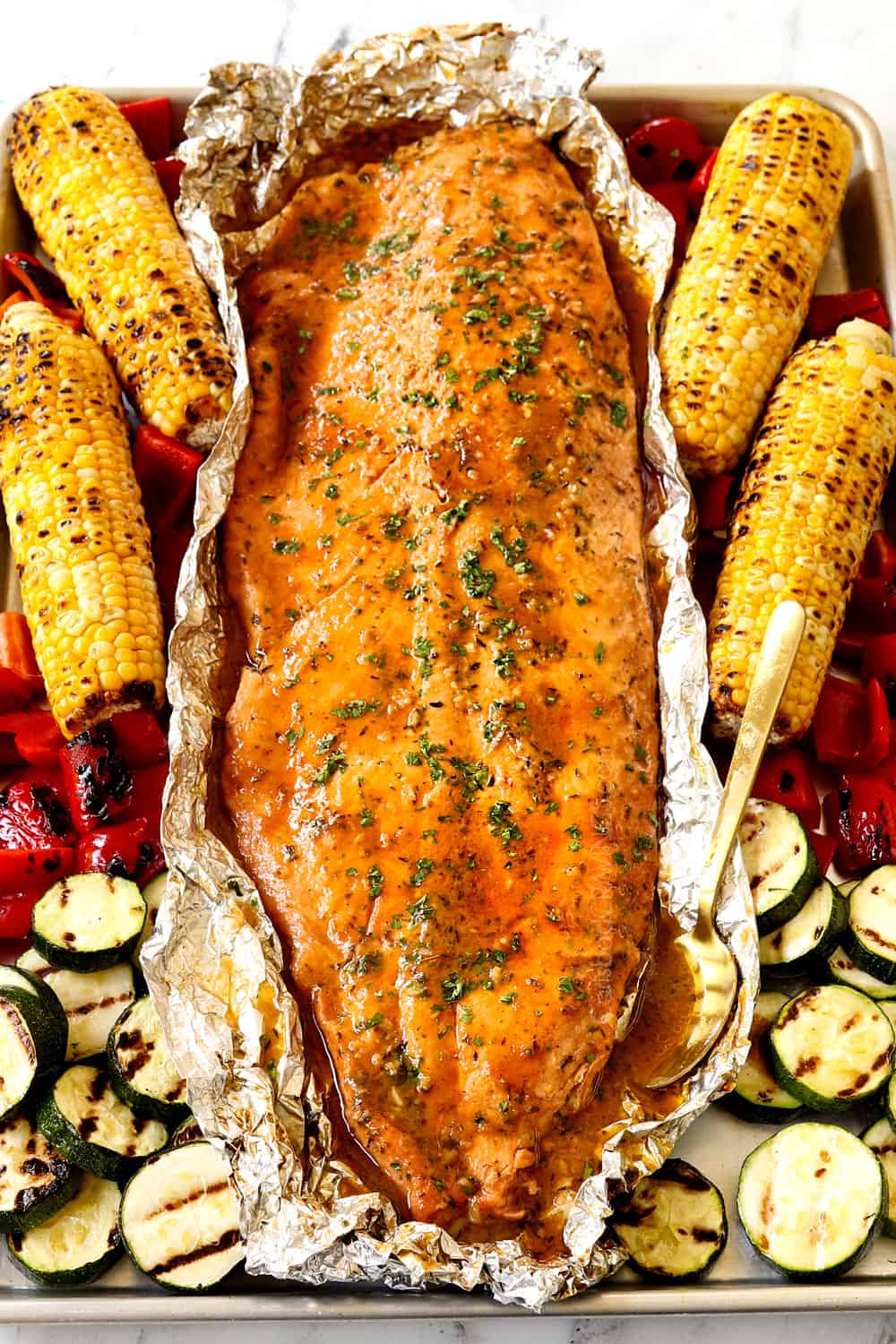
Want to make salmon packets with vegetables?
This grilled salmon in foil recipe can easily be made into individual salmon foil packets with veggies. Before marinating, slice the raw salmon into individual fillets and make a packet for each person, plan on 1-2 fillets per pouch. Make sure to leave room for some veggies.
Lightly grease the foil, add the salmon fillet(s), then pour the marinade over top. Marinate at room temperature for 30 minutes before adding the butter and veggies of choice. You will want to use quick cooking vegetables such zucchini, summer squash, asparagus, or cherry tomatoes. Avoid longer cooking vegetables such as carrots, broccoli or potatoes unless you par-boil or steam them first. Seal up the foil packet and grill per recipe instructions.
can i make salmon ahead SALMOn?
The salmon should only be marinated for 30-45 minutes then grilled right away. If you want to prep the recipe in advance, you can:
- Prep salmon: add the salmon to the lightly greased foil, seal and store in the refrigerator.
- Prep marinade: whisk the marinade ingredients together and store in an airtight container in the refrigerator WITHOUT the salmon for up to 3 days.
HOW TO STORE SALMON in foil
Store leftover salmon in an airtight container in the fridge for up to three days. The leftovers (if there are any) are wonderful in scrambled eggs, pasta, tacos, burritos, rice bowls, salads, etc. I’ve included all sorts of ways to enjoy leftover salmon a few sections below.

HOW TO FREEZE GRILLED SALMON
You can freeze leftover salmon for up to 3 months. To freeze, place individual salmon fillets in a freezer size bag along with any extra sauce, squeeze out excess air to preserve freezer burn, label and freeze. I love the option of pulling out individual salmon fillets and have added this particular salmon recipe to scrambled eggs and salad for the win!
HOW TO REHEAT GRILLED SALMON
- From the fridge: gently reheat the salmon in a skillet, covered, for about 5 minutes or in the microwave at 30-second intervals. You can also warm the salmon in foil in the oven for 10-15 minutes at 275 degrees F, until it reaches an internal temperature of 125°F to 130°F. Take care not to overcook the salmon or it will become dry.
- From frozen: thaw salmon in the refrigerator overnight then reheat per any of the above methods.
WHAT SIDES SHOULD I SERVE WITH GRILLED SALMON?
This grilled salmon in foil is so flavorful, it doesn’t need any fancy sides. Just serve it with some mashed potatoes or rice, salad and watermelon and call it a day! Still, it would also be delicious with:
- Salsas! This salmon recipe is especially delicious, paired with bright, fresh, crunchy, sweet, tangy salsa such as: mango salsa, pineapple salsa, pineapple mango salsa, corn salsa, strawberry salsa or pico de gallo.
- Grains: a favorite of ours is this salmon recipe with coconut rice or cilantro lime rice. You can also serve it with wild rice, quinoa, or cauliflower rice.
- Salads: this robust, flavorful salmon pairs well with big refreshing salad such as watermelon feta salad, broccoli bacon salad, potato salad, strawberry spinach salad and berry spinach salad, corn salad, or Mexican street corn salad.
- Pasta salad: nothing says summertime like pasta salad! We love Mexican pasta salad, Italian tortellini salad, creamy bacon pea pasta salad, BLT pasta salad just to name a few.
- Fruit: watermelon, cantaloupe, pina colada fruit salad, fruit salad with honey lime vinaigrette, grape salad, summer fruit salad or caramelized grilled pineapple.
- Potluck Favorites: baked mac and cheese, sweet cornbread, loaded potato salad, potato salad, baked beans, corn casserole, elote (Mexican Street Corn) and grilled corn on the cob.
- Dessert: top off the feast with peach cobbler, tres leches cake, strawberry pie, lemon pound cake, strawberry shortcakes or blueberry cheesecake, lemon cheesecake bars.
WHAT ELSE CAN I MAKE WITH GRILLED SALMON?
This grilled salmon recipe is fabulous in its simplicity or it is magical in its versatility. The Cajun honey mustard marinade lends itself to so many different types of cuisines and dishes. Here are just a few to make with leftovers or with the salmon hot off the grill:
- Grilled Salmon Salad: I LOVE adding salmon leftovers to this salad. Add salmon to a bed of baby arugula, spring mix or spinach along with cucumbers, craisins, feta, sliced almonds and sunflower seeds. Drizzle with olive oil and balsamic vinegar or I love mine with peach vinegar (you don’t even need to add oil!).
- Breakfast foods: add flaked salmon to quiche, frittata, eggs benedict, or scrambled eggs or serve on the side of any type of eggs – so good!
- Grilled Salmon Pasta: add salmon to any of your favorite pastas such as Fettuccine Alfredo, Sun-Dried Tomato Fettuccine, Cacio e Pepe, Creamy Mushroom Pasta, Pepper Jack Mac and Cheese or Homemade Mac and Cheese. You can also go low carb and serve it with zoodles or spaghetti squash.
- Grilled Salmon risotto: stir salmon into any of your favorite risotto recipes: Mushroom Risotto, Parmesan Risotto, Spinach Risotto – yum!
- Grilled Salmon grain bowls: add your favorite grains to a bowl and pile with salmon and your favorite veggies. The veggies can be roasted/cooked like roasted broccoli, cauliflower, Brussels sprouts or butternut squash, or raw such as fresh tomatoes, thinly sliced radishes, sprouts etc. or pickled like pickled jalapenos, carrots, etc. or a combo of all three! You can also top with a fried or soft-boiled egg.
- Grilled Salmon Tacos: top tortillas with black or pinto beans, salmon and desired toppings. Pick from avocado corn salsa, corn salsa, avocado crema or guacamole, cotija cheese, pickled red onions and/or hot sauce.
- Grilled Salmon Burritos: layer a burrito size tortilla with plain rice, cilantro lime rice or Mexican Rice, black or pinto beans, salmon, avocado corn salsa and sour cream.
- Grilled Salmon Burrito Bowls: layer cilantro lime rice or cauliflower rice with cheese, black beans or pinto beans, salmon, chopped lettuce, and your favorite toppings including tomatoes, corn, crushed tortilla chips and either sour cream/Greek yogurt or I highly recommend either Avocado Crema, Tomatillo Avocado Ranch or Cilantro Lime Dressing.
HELPFUL facts for grilled salmon in foil
We ingest a small amount of aluminum every day through food, water and/or medication. However, the aluminum content of food and medication isn’t considered to be a problem because the body can only actually absorb a small amount. Grilling fish in foil can increase the amount of aluminum in your food, however, the amounts are very small and likely insignificant, and deemed safe by researchers. (Healthline)
Yes! Simply prepare the recipe per instructions and place on a baking sheet. Bake in the oven to 400ºF for 10-15 minutes for 1-inch salmon and 15-20 minutes for 1 1/2-inch salmon.
The purpose of grilling salmon in foil is to create a steam trap to create super moist salmon. It doesn’t necessarily cook faster, but it does cook more evenly, retains more moisture, keeps the grill clean and makes it more flavorful as the marinade seeps back into the fish as it cooks.
Nope! It may char against the grill grates but you can safely use it on the grill without worrying about it burning.
No, please don’t! Please take care when handling the foil packet that you don’t accidently poke a hole in the foil, otherwise the marinade and the juices will seep out and you’ll be left with a mess and less juicy salmon.
You should NOT rinse your fish before cooking! The USDA cautions: “do not rinse raw fish, seafood, meat, and poultry. Bacteria in these raw juices can splash and spread to other foods and surfaces. Cooking foods thoroughly will kill harmful bacteria.”
Although a whole fillet looks like a lot of protein, it goes down surprisingly easy! There are quite a few variables to when it comes to serving size such as what you are serving with your salmon and how big of eaters your audience is, but the general rule of thumb is about ½ pound per person, so one 2-pound fillet will serve 4 people, one 3-pound salmon fillet serves six people.
Salmon is be a low-calorie protein source that is rich in heart-healthy omega-3s, and low in saturated fat. It is also an excellent source of several B vitamins, antioxidants and potassium. Studies show that salmon can help lower inflammation, which may reduce the risk factors for several diseases. A growing number of studies also suggest that including salmon in your diet might improve brain function and even reduce symptoms of anxiety, depression and the risk of age-related memory problems.
Absolutely! In fact, the skin contains more of the same minerals and nutrients contained in salmon, so it is highly nutritious. With this recipe, however, I suggest removing the skin because it does not get crispy and isn’t needed because the foil acts as the barrier from the heat to keep the fish moist.


Honey Mustard Grilled Salmon in Foil
Save This Recipe To Your Recipe Box
You can now create an account on our site and save your favorite recipes all in one place!
Ingredients
Salmon
- 1 large salmon fillet, skin removed (about 3 pounds)
HONEY MUSTARD MARINADE
- 1/3 cup freshly squeezed orange juice
- 1/3 cup honey
- 3 tablespoons Dijon mustard
- 3 tablespoons yellow mustard
- 2 tablespoons brown sugar
- 2 tablespoons olive oil
- 1 tablespoon reduced sodium soy sauce
- 4 cloves garlic, minced
- 3/4 teaspoon salt, plus more to taste
- 1 teaspoon smoked paprika
- 1/2 tsp EACH dried parsley, dried oregano, dried thyme, onion powder, pepper
- 1/4-1/2 teaspoon cayenne pepper
ADD LATER
- 3 tablespoons Danish Creamery butter, cubed
Instructions
- Line a large baking sheet (large enough to hold your salmon) with heavy duty foil (or double the foil) that is 6-inches longer than your salmon (so you can fold the sides up). Lightly spray the foil with cooking spray. Place salmon in the center and fold the foil up snuggly around the salmon; set aside.
- Whisk all of the marinade ingredient together in a medium bowl. Pour the marinade evenly over the top of the salmon. Let the salmon marinate at room temperature for 20-40 minutes. Preheat your grill the last 15 minutes of marinating time to 375-400 degrees F with the lid closed.
- When ready to grill, evenly space the cubed butter over top of the salmon. Place a second piece of foil on top and fold the edges under to form a sealed packet, leaving a little tented room at the top for air circulation.
- Carefully slide the salmon packet directly onto the grill. Close the grill and cook salmon for 15-20 minutes depending on thickness, or until the salmon registers 130-135 degrees on an instant read thermometer inserted into the thickest part. (1-inch thick salmon can take as little as 10 minutes, 1 ½-inch thick salmon will take closer to 20 minutes.)
- To remove the salmon from the grill, carefully slide the foil packet back onto the baking sheet with the help of a spatula (careful, the foil packet will be hot!). Remove the top foil (watch for steam). Spoon the buttery sauce accumulated at the bottom of the foil all over the top of the salmon. Let the salmon rest for 5 minutes before slicing and serving. Season with freshly cracked salt and pepper to taste; garnish with fresh parsley if desired.
Video
Notes
- Baked salmon in foil. Add the salmon to the foil and marinate per recipe instructions. Bake in foil on top of a baking sheet in the oven at 400°F for 10-20 minutes, closer to 10 minutes for 1 inch, closer to 20 minutes for 1 ½ inch.
- Salmon in foil. If you do not want your salmon to touch the foil directly, you can lay a sheet of parchment paper on top of the foil. Cooking food directly in foil is a health concern to some, but the aluminum adds to your diet is negligible (I’ve detailed this in the post below). Still, so do whatever makes you the most comfortable.
- Use a baking sheet! Adding the salmon to the baking sheet makes for easy transportation of the salmon to and from the grill. The less you have to handle the foil salmon packet, the better, because there will be less chances of it tearing. You don’t want to accidently poke a hole in the foil, otherwise the marinade and the juices will seep out and you’ll be left with a mess and less juicy salmon.
- Don’t over-marinate salmon. Because fish is so tender, 45 minutes is the maximum amount of time you should marinate with an acidic marinade. If the fish is left too long in the marinade, it can become mushy. This means you have to start heating your grill after the salmon has been marinating for 15-30 minutes.
- Remove foil away from you. Transfer cooked salmon to a heat-proof flat surface from the baking sheet and carefully remove the top piece of foil. It will release a lot of steam, so take care to remove the foil away from you.
- Reseal the fish or pop it back on the grill. If you don’t have a meat thermometer and your salmon appears a bit underdone, simply wrap it back up in the foil and let it rest on the counter for a few minutes. If it’s severely underdone, pop it back on the grill. In either case, take care, salmon can progress from undercooked to overcooked very quickly.
- How to serve salmon (leftovers): see post for all sorts of ideas to serve the salmon, including leftovers.
- Salmon packets with vegetables. This grilled salmon in foil recipe can easily be made into individual salmon foil packets with veggies. Before marinating, slice the raw salmon into individual fillets and make a packet for each person, plan on 1-2 fillets per pouch. Make sure to leave room for some veggies. Lightly grease the foil, add the salmon fillet(s), then pour the marinade over top. Marinate at room temperature for 30 minutes before adding the butter and veggies of choice. You will want to use quick cooking vegetables such zucchini, summer squash, asparagus, or cherry tomatoes. Avoid longer cooking vegetables such as carrots, broccoli or potatoes unless you par-boil or steam them first. Seal up the foil packet and grill per recipe instructions.
Make ahead
The salmon should only be marinated for 30-45 minutes then grilled right away. If you want to prep the recipe in advance, you can:- Prep salmon: add the salmon to the lightly greased foil, seal and store in the refrigerator.
- Prep marinade: whisk the marinade ingredients together and store in an airtight container in the refrigerator WITHOUT the salmon for up to 3 days.
HOW TO STORE and reheat
- To store: store leftover salmon in an airtight container in the fridge for up to three days. The leftovers (if there are any) are wonderful in scrambled eggs, pasta, tacos, burritos, rice bowls, salads, etc. I’ve included all sorts of ways to enjoy leftover salmon in the post.
- To freeze: you can freeze leftover salmon for up to 3 months. To freeze, place individual salmon fillets in a freezer size bag along with any extra sauce, squeeze out excess air to preserve freezer burn, label and freeze. I love the option of pulling out individual salmon fillets and have added this particular salmon recipe to scrambled eggs and salad for the win! Thaw salmon in the refrigerator overnight then reheat per any of the below methods.
- To reheat from the fridge: gently reheat the salmon in a skillet, covered, for about 5 minutes or in the microwave at 30-second intervals. You can also warm the salmon in foil in the oven for 10-15 minutes at 275 degrees F, until it reaches an internal temperature of 125°F to 130°F. Take care not to overcook the salmon or it will become dry.

Did You Make This Recipe?
Tag @CarlsbadCravings and Use #CarlsbadCravngs
Leave a Review, I Always Love Hearing From You!
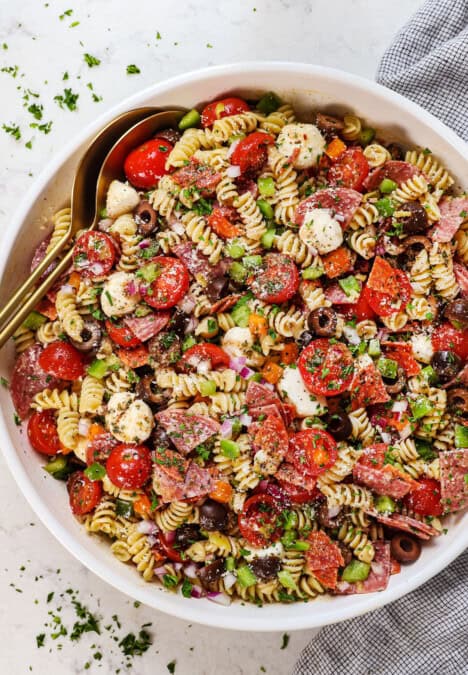



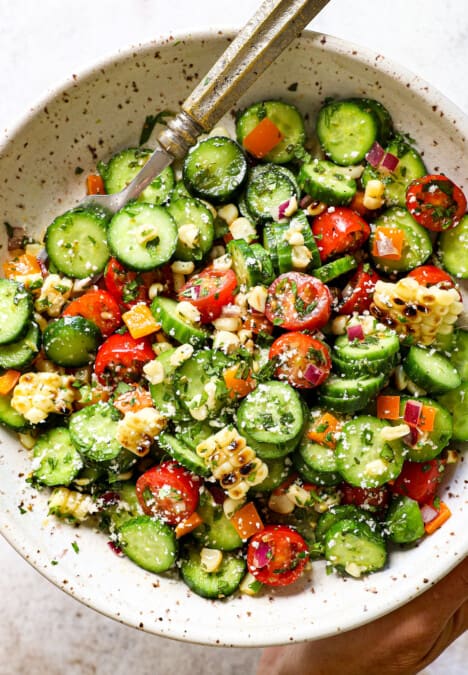
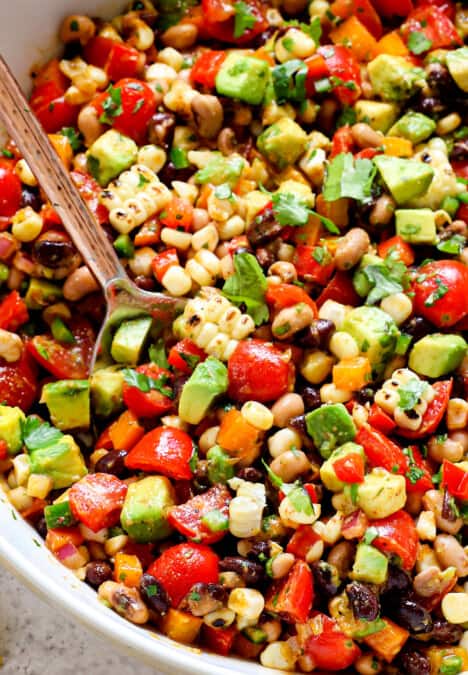

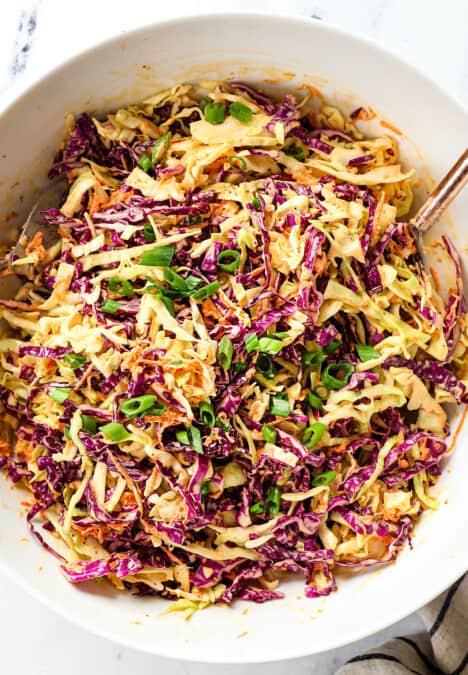
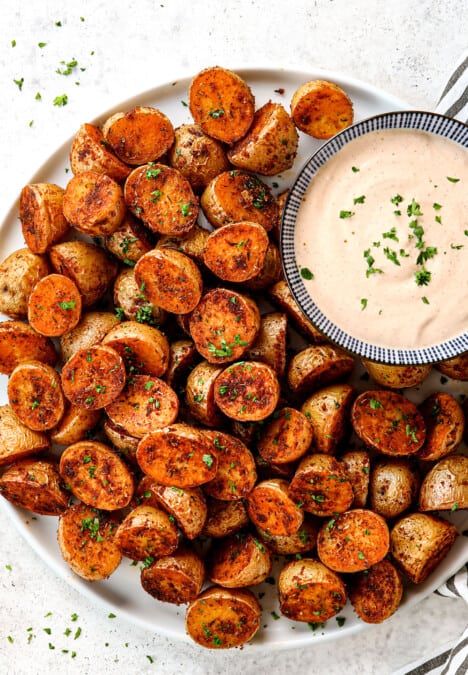

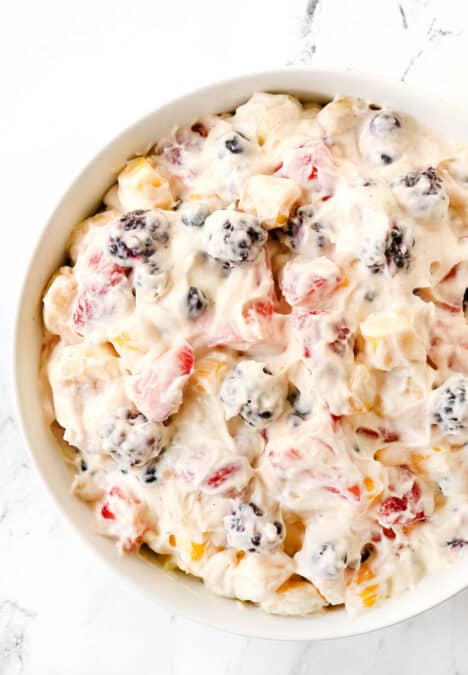
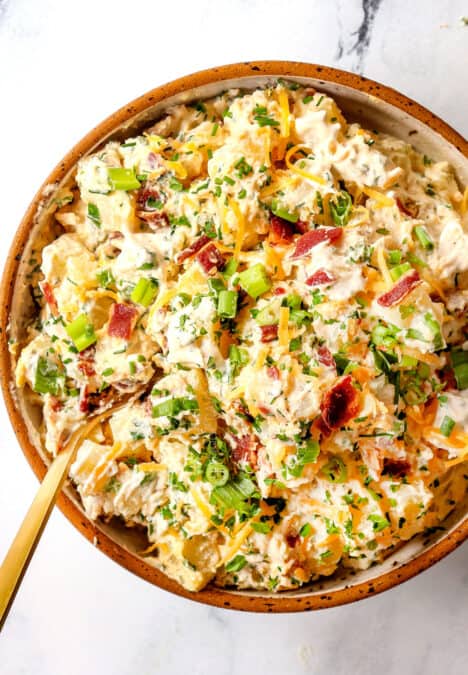

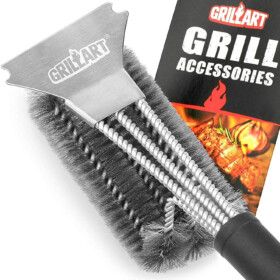
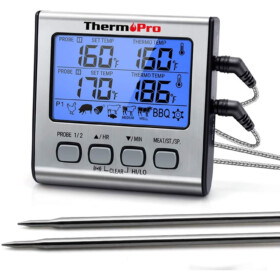
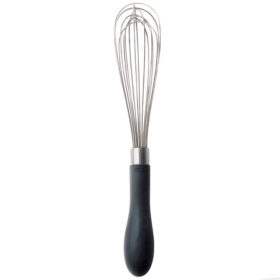
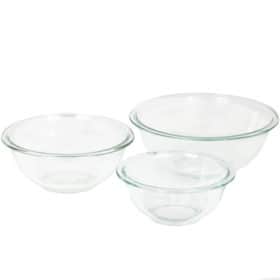
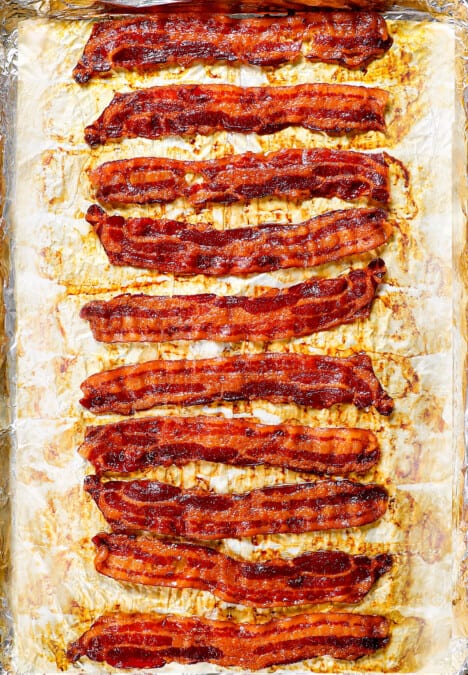
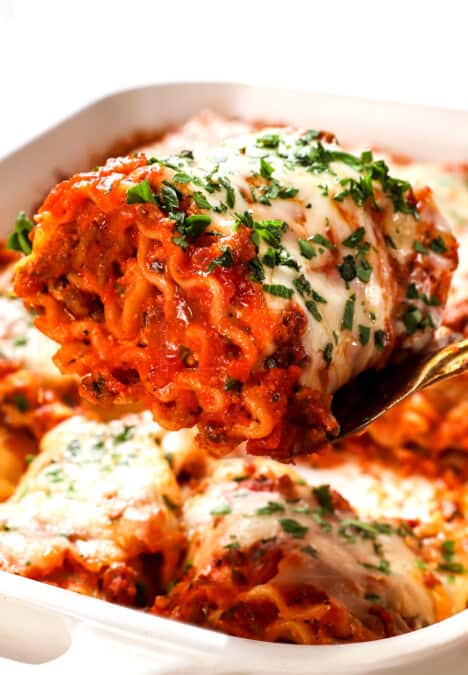
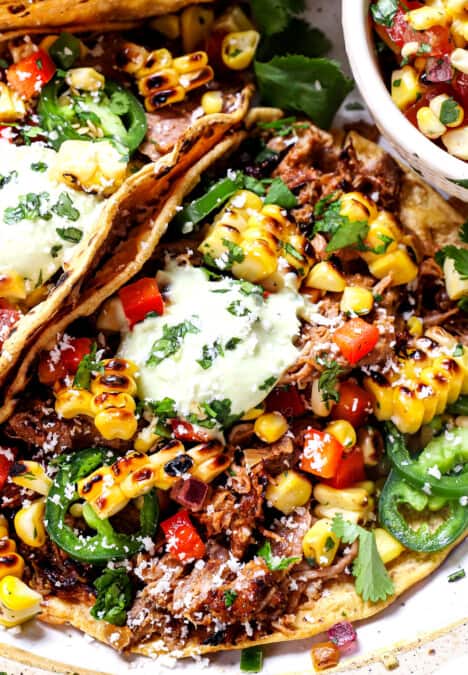
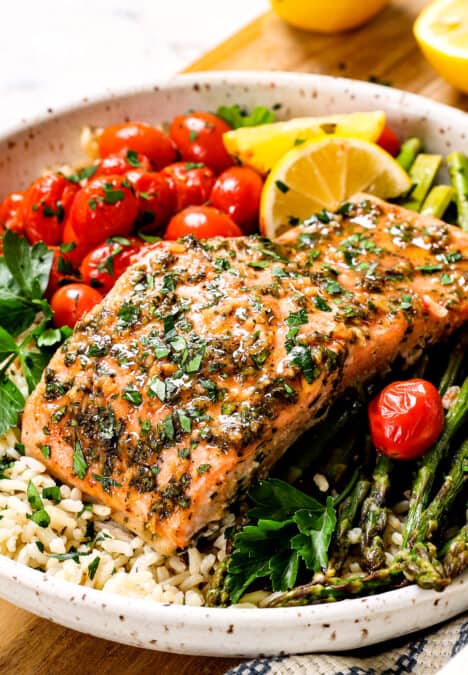
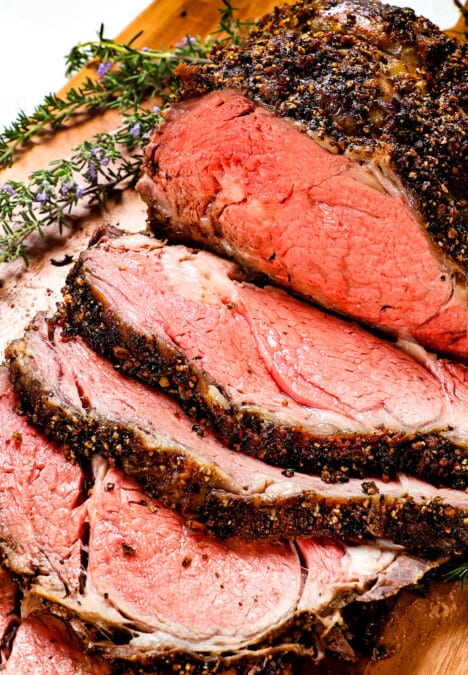
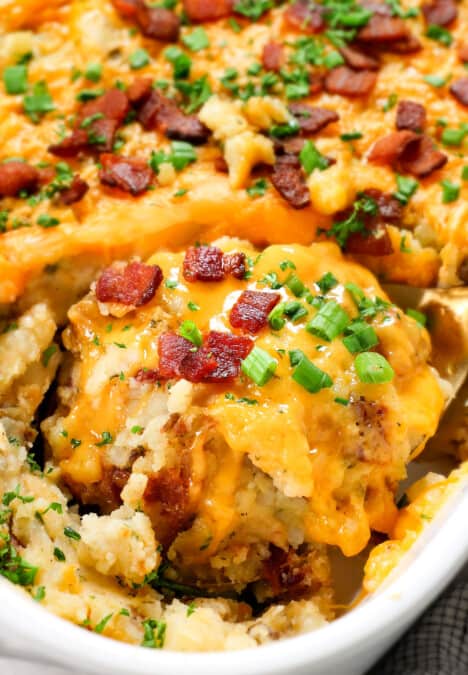























Ramya says
Will be making this soon can i use mushrooms / maple syrup and vegan butter as am a vegan can i use oven as i dont have a grill at home perfect for my after office meals will dm you if i make this and let you know how it goes Thanks Ramya
Jen says
Thanks Ramya, enjoy!
Debbie says
can this be made in the oven
Jen says
Yes! Bake at 400 degrees F for 15-20 minutes in the foil on a baking sheet.
Phyllis says
Hey Jennifer, I have an event coming up soon. I would like to make this salmon early in the day and serve it cooled to room temp (not cold) in the evening. Will that work with this marinade, or will the butter harden?
Jen says
Hi Phyllis, I think you’ll be just fine serving it at room temp. The butter mingles with the rest of the marinade ingredients so it doesn’t harden. Enjoy!
Patricia Bontrager says
Made this last night and we absolutely loved it! Since it’s winter, I baked it in the oven and it worked perfectly. The sauce was absolutely heavenly! We ate the salmon over couscous. Thanks so much for sharing the recipe!
Jen says
You’re so welcome Patricia, I’m so pleased you loved it so much!
Hope Mayer says
I made this for dinner tonight and it was so delicious!! That marinade was everything!! I cooked it in the oven for about 17 mins and it came out perfect! Afterwards I realized I forgot the butter. I’ll have to try it next time that way! I also made your carnitas that you posted on Instagram for Super Bowl and we did everything from nachos to tacos to quesadillas, it was as AMAZING as all the reviews stated! I’m your newest big fan! From a girl who loves to cook for her four boys, THANK YOU!!
Jen says
Thanks so much for taking the time to comment Hope! I love hearing how much you loved both the salmon and the carnitas. Your carnitas creations sound epic! I’m excited for you to try more of my recipes!